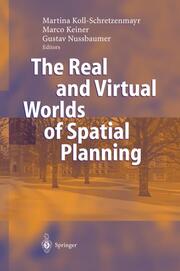-
Zusatztext
-
InhaltsangabePart I. The Real World of Spatial Planning.- Spatial Planning in the Twenty First Century.- Venice, Venice, Venice- Three Realities of the European City.- Sustainable Development and Urban Management in Developing Countries.- Indicator Sets on City and Cantonal Levels in Swtitzerland.- Implementing Sustainable Urban Development.- Transforming Cityspace.- City of Regions.- Increasing Resistance to Political Consulting.- Evaluation and Decision Support Systems in Multiple Land Use Planning.- Part II. The Virtual World of Spatial Planning.- Dynamic Immersive Visualization.- Behavioral Monitoring in Virtual Environments.- Assessment of Urban Green Space Qualities Using 3D Visualization Tools.- Movism.- Hiking in Real and Virtual Worlds.- Complex Systems Applications for Transportation Planning.- On the Variability of Human Activity Spaces.- Networked Systems.- Material Flow Analysis as a Tool for Sustainable Management of the Built Environment
-
-
Kurztext
-
The Real and Virtual Worlds of Spatial Planning brings together contributions from leaders in landscape, transportation, and urban planning today. The authors present an international range of case studies - from Europe, Australia, North America, Asia and Africa - that ground the exploration of ideas in the realities of sustainable urban and regional planning, landscape planning and present the prospects for using virtual worlds for modeling spatial environments and their application in planning. The first part of this volume explores the challenges for planning in the real world that are caused by the dynamics of socio-spatial systems as well as by the contradictions of their evolutionary trends related to their spatial layout. Case studies from developed as well as developing countries are presented. The second part presents diverse concepts to model, analyze, visualize, monitor and control socio-spatial systems by using virtual worlds. Theoretical topics include modeling spatial systems as Petri nets, cellular automata as well as dynamical systems.
-
Detailansicht
The Real and Virtual Worlds of Spatial Planning
ISBN/EAN: 9783642073946
Umbreit-Nr.: 1567764
Sprache:
Englisch
Umfang: xiii, 306 S.
Format in cm:
Einband:
kartoniertes Buch
Erschienen am 30.11.2010
Auflage: 1/2004


